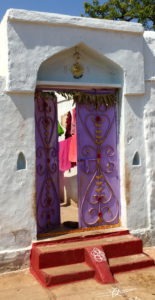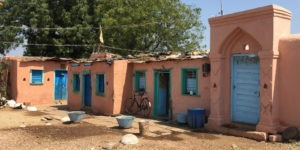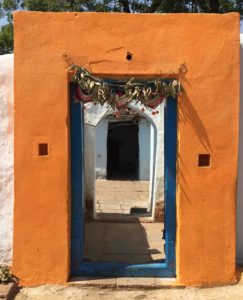Medieval Majesty
I’m a big fan of Indian forts, and when I read William Dalrymple’s entrancing book White Mughals and his description of the fort town of Bidar, I couldn’t believe that I’d missed this place on an earlier visit to Hyderabad, the nearest big city. So the first site pencilled in for our 2018 visit to India was Bidar’s incredible fort.
Hardly on the tourist map
Now, there’s not much information out there on Bidar. Lonely Planet (yes, I know, but I’m of that generation) barely mentions it, Trip Advisor has the usual lists but not a great deal of helpful details for overseas visitors. We wanted to travel primarily by train (less scary than Indian buses), and rather than do a “there-and-back” we found a little loop of other fort towns in the area west of Hyderabad. Our route was Hyderabad – Solapur – Gulbarga – Bidar – Hyderabad.
I’m surprised more overseas tourists don’t visit; I somehow imagined meeting a few intrepid Dalrymple-wielding Brits, yet we encountered not one single overseas visitor during our three-night stay. Backpackers don’t seem to “wander” around India on a whim anymore, and even the posh tours (Cox & Kings, Abercrombie & Kent) seem to ignore it. There is a distinct lack of decent accommodation, which doesn’t help tap into the affluent end of the market, and the four-hour, one-way road journey from Hyderabad rules out the day-trippers.
We spent three nights in Bidar in mid-October, which is a good time of year to visit – dry, not too hot. We stayed at the somewhat quirky Hotel Mayura Bidar, more of which later.
Bidar Fort - it's free to visit!
But let’s get to the fort first, because it is the main reason for being here. It doesn’t disappoint. And what’s more, for an Indian monument it is very notable in being FREE. Yes, that’s right — not only do they not charge foreign visitors 10 times more than locals, they don’t actually ask for anything!
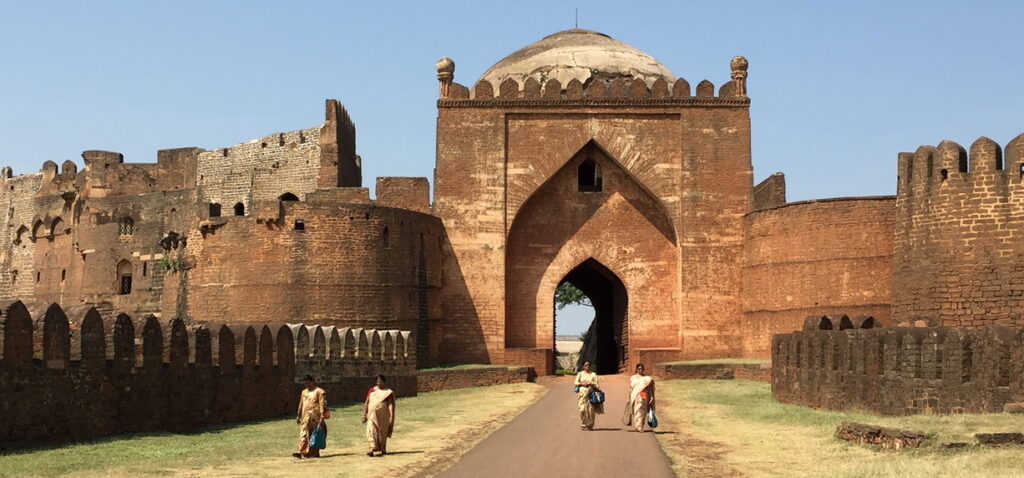
It’s a sprawling site, with 2.5km of walls running across the landscape in a rough rectangle, pierced by mammoth gates and fortified with numerous bastions. An ordinary road used by local villagers runs through it — probably the reason why they can’t charge people to enter as the road literally runs under the archways of the gates. Inside the compound are palaces, pavilions, two mosques, gardens, gateways and archways, built by the Bahmani kings in the Persian style. Unfortunately, you only really get to see the outside of most of these buildings; for one reason or another they are closed off.
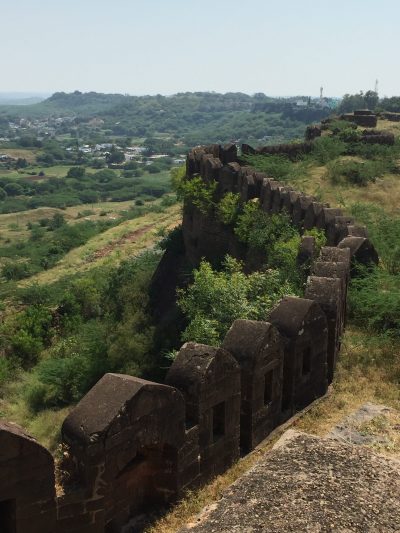
The fort was founded by Ala-ud-Din Bahman Shah in 1427. He was the first king, or sultan, of the Bahmani dynasty, and he shifted his capital to Bidar from nearby Gulbarga. Find out more about the Bahmanis at the foot of this page.
We were very interested in the Solah Khamba mosque, named for the front row of 16 pillars, which we could tantalising peer into through a metal fence, but it was locked up. Somebody indicated it would be open the following day, and we returned — to find it still closed. I turned my (not very famous) charm on for one of the fort guards (“we’ve come all the way from overseas to see your beautiful mosque, sir…”); this worked and he unlocked the gate, also allowing in a grateful and friendly group of Indian tourists. The interior is cool and calm, dominated by a forest of thick columns; it was completed in 1424 and is reputedly the oldest building in Bidar, pre-dating the fort.
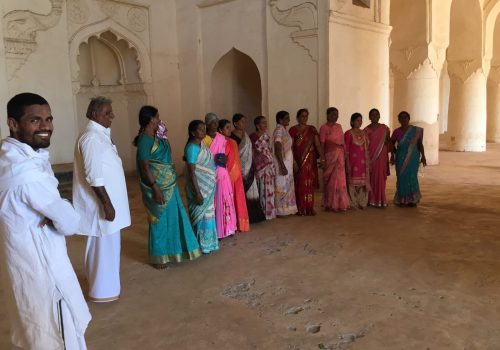
The fort’s little museum is basic, but has some lovely sculptures and pieces of patterned tiles. Photography is not allowed, but I did some quick drawings in my sketchbook, made notes of the colours, and filled them in with watercolour back in my hotel later. You can see more of my India artworks here.
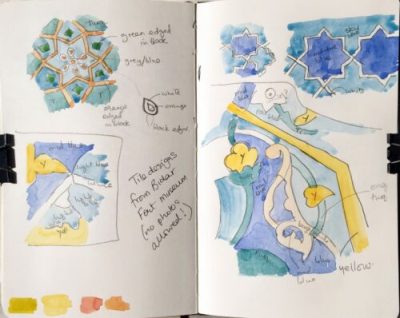
Quiet corners
The best thing about Bidar fort, though, is that you can just wander around quite peacefully. There aren’t hordes of visitors and because it is so extensive you can easily while away an hour or so, finding a quiet corner to sit and admire the views. One of the bastions is easily accessible through the little village within the walls (the road along the wall behind the museum).
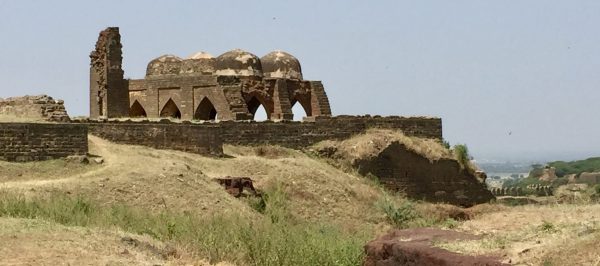
The panorama from here is gorgeous – and we weren’t disturbed once while up there, This is unusual for India, where someone is almost always around and wants to ask you where you’re from, what you do, what you think of India. It’s lovely that people want to chat, but it can get tedious. The doorways of the village houses are painted in a variety of bright and cheerful colours – orange, blue, lilac, deep purple.
We saw no sign of the famous karez water system that taps into the groundwater and delivers it by tunnel to where it is needed — that’s the downside of no entrance fee, as little effort is made to signpost and give explanations.
Practicalities of visiting Bidar Fort
Talking of water, there are toilets (fairly clean) on site, but nowhere to buy water, soft drinks or snacks. There is a very basic eatery over the road from the main gate where you can get cheap Indian fare and chai. Lonely Planet mentions a rather lovely sounding outdoor restaurant by the gate “under the tamarind trees”, but we could find no trace of it.
We found it fairly easy to get auto-rickshaws to take us out to the fort from our hotel, but it’s a good idea to have “Bidar Fort” written in large letters in the local Kannada language. We had a little bit of a wait to find transport going back to the centre, but nothing too dramatic.
Is it worth it?
Verdict? The fort was fab. Most definitely “Bidar’s inccredible fort”. If tramping around ruins, having done a bit of reading up on the history of the area before you go is your thing, then you’ll enjoy it. And if you’re into history and tales of swashbuckling derring-do, read Dalrymple before you go.
More on Bidar – including what else there is to see and hotel review next post, including what the hotel manager called many of his guests
Your Bahmani Kings Cheat Sheet
- Founded in 1347 by Allauddin Hassan following his rebellion agains the Sultan of Delhi. He adopted the name Bahmani in honour of his patron who was a Brahmin
- The sultanate was established in nearby Gulbarga, but the capital shifted to Bidar in 1425
- The dynasty lasted almost 200 years, with approximately 18 different rulers; apparently, five were murdered, three were deposed, two drank themselves to death and two were blinded
- The most admired of the kings was Firoz Shah (1397-1422), a cultured man well versed in science and literature
- The apogee of the sultanate came under the prime ministership of Mahmud Gawan who served three sultans between 1458 and 1481. He expanded the empire and introduced administrative reforms, but as a Persian was always considered an outsider and was eventually executed
- The Bahmani kingdom was almost always at war with its southern neighbour, the Vijaynagar Empire; internal strife was also nearly always present
- The sultanate eventually fell apart under weak leaders and divided into five separate states, including the Barid Shahi kingdom of Bidar
